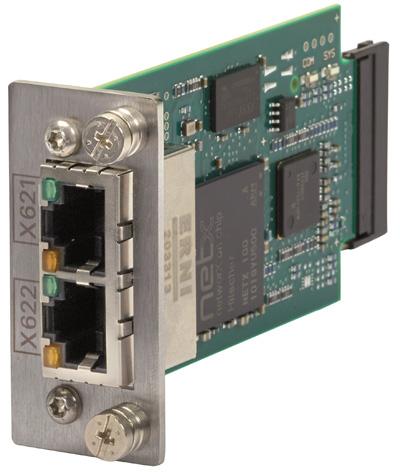
HEIDENHAIN offers a new interface board for PROFINET-IO, giving those interested in the conversationally friendly TNC controls more options than ever. This common PROFINET-IO (ID 825866-02) will be available in addition to the interface board for PROFIBUS-DP (ID 828539-01) that is already being used in the field.
PROFINET-IO is the consistent improvement over PROFIBUS-DP. PROFINET-IO is an open industrial Ethernet standard that conforms to IEC 61158 and IEC 61784-2. Real-time communication is used to transfer user data and alarms, while configuration and diagnosis are supported via TCP/IP or other IT protocols.
All PROFINET-IO field-bus devices that have been certified by the PROFIBUS user organization and provide device files in GSDML format can be connected as consumers within PROFINET-IO's provider-consumer concept (formerly called master-slave). The interface board is certified for Conformance Class A and must be used as a provider. The interface board is not suitable for isochronous real-time applications (Conformance Class C, e.g. motion control).
To configure the bus systems that can be connected to the TNC, the IOconfig PC software with version 3.0 or higher is required. IOconfig can also be used to configure field-bus devices from other manufacturers for PROFIBUS-DP or PROFINET-IO if appropriate device files are provided.
The following hardware supports the PROFINET interface: MC 6441, MC 65xx, MC 66xx, MC 74xx, MC 75xx. Furthermore, the following software is compatible with the PROFINET interface: the versatile mill-turn control TNC 640 (as of version 34059x-05), the solid and highly accurate mill control TNC 620 (as of version 81760x-02), the versatile lathe control CNC PILOT 640 (as of version 68894x-03) and the solid and user-friendly lathe control MANUALplus 620 (as of version 54843x-03).
Contact Details
Related Glossary Terms
- computer numerical control ( CNC)
computer numerical control ( CNC)
Microprocessor-based controller dedicated to a machine tool that permits the creation or modification of parts. Programmed numerical control activates the machine’s servos and spindle drives and controls the various machining operations. See DNC, direct numerical control; NC, numerical control.
- lathe
lathe
Turning machine capable of sawing, milling, grinding, gear-cutting, drilling, reaming, boring, threading, facing, chamfering, grooving, knurling, spinning, parting, necking, taper-cutting, and cam- and eccentric-cutting, as well as step- and straight-turning. Comes in a variety of forms, ranging from manual to semiautomatic to fully automatic, with major types being engine lathes, turning and contouring lathes, turret lathes and numerical-control lathes. The engine lathe consists of a headstock and spindle, tailstock, bed, carriage (complete with apron) and cross slides. Features include gear- (speed) and feed-selector levers, toolpost, compound rest, lead screw and reversing lead screw, threading dial and rapid-traverse lever. Special lathe types include through-the-spindle, camshaft and crankshaft, brake drum and rotor, spinning and gun-barrel machines. Toolroom and bench lathes are used for precision work; the former for tool-and-die work and similar tasks, the latter for small workpieces (instruments, watches), normally without a power feed. Models are typically designated according to their “swing,” or the largest-diameter workpiece that can be rotated; bed length, or the distance between centers; and horsepower generated. See turning machine.
- milling machine ( mill)
milling machine ( mill)
Runs endmills and arbor-mounted milling cutters. Features include a head with a spindle that drives the cutters; a column, knee and table that provide motion in the three Cartesian axes; and a base that supports the components and houses the cutting-fluid pump and reservoir. The work is mounted on the table and fed into the rotating cutter or endmill to accomplish the milling steps; vertical milling machines also feed endmills into the work by means of a spindle-mounted quill. Models range from small manual machines to big bed-type and duplex mills. All take one of three basic forms: vertical, horizontal or convertible horizontal/vertical. Vertical machines may be knee-type (the table is mounted on a knee that can be elevated) or bed-type (the table is securely supported and only moves horizontally). In general, horizontal machines are bigger and more powerful, while vertical machines are lighter but more versatile and easier to set up and operate.

